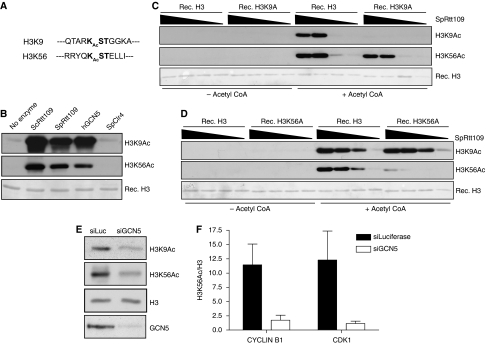Figure 5.
hGCN5 acetylates H3K9 and H3K56 in vitro and in vivo. (A) The H3K9 and H3K56 motifs share sequence similarity. (B) Human GCN5 acetylates H3K9 and H3K56 in vitro. HAT activity towards H3K9 and H3K56 was assessed with purified S. cerevisiae and S. pombe Rtt109 (ScRTT109 and SpRTT109, respectively) or human GCN5 (hGCN5) in an in vitro HAT-assay containing purified human recombinant histone H3.1 (Rec. H3) with subsequent analysis by western blotting with the indicated antibodies. SpClr4 was used as a non-HAT enzyme and a ponceau staining of Rec. H3 is shown as a loading control. (C) H3K9Ac antibody is specific. Purified SpRtt109 was incubated with Rec.H3 or Rec. H3 containing a Lys9 to Ala mutation (H3K9A) and analysed as in A. (D) H3K56Ac antibody is specific. Experiments were done as in B except Rec. H3K56A was used instead of Rec. H3K9A. (E) hGCN5 is involved in acetylation of H3K9 and H3K56 in vivo. U2OS cells were transfected with siRNAs against luciferase (siLuc) or GCN5 (siGCN5) and samples were analysed after 48 h by western blotting of whole cell Laemmli extracts with the indicated antibodies. (F) GCN5 depletion leads to the loss of H3K56Ac at promoters of cell-cycle regulatory genes. U2OS cells were transfected as in E and analysed as in Figure 4E.

